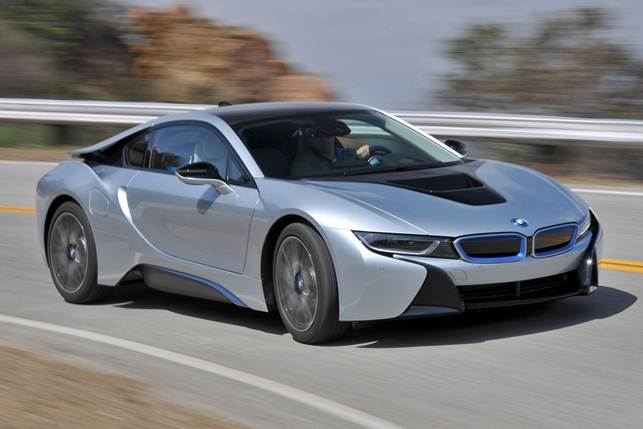BMW’s futuristic i8 hybrid is said to
deliver all we crave in a sports car with half the fuel
BMW’s i8 is both a car and a preview of the
marque’s future. This is fitting, because everyone who sees the i8 assumes it
is, in fact, from the future. But before we deconstruct how the car is built
and its singular driving manners, it’s only right that we celebrate BMW’s sheer
chutzpah in building a production machine so faithful to the company’s
beautiful 2009 Vision EfficientDynamics concept. When was the last time a
production car looked so much like it had escaped from an auto show stand?
Maybe that wasn’t a brave decision, merely
ambitious. The styling, after all, was right, and by 2010 the light was green
to build a plug-in hybrid sports car with a carbon-fiber-intensive chassis
housing two electric motors, a tiny internal-combustion engine, and a performance
package encompassing zero-emissions cruising and supercar-pace canyon attacks.
All this from a company that, until recently, backed hydrogen fuel cells as the
new automotive dawn. It was a massive undertaking.

The
i8 offers excellent body control, responding quickly and precisely
Some have compared the i8 to BMW’s last
mid-engine sports car, the M1 of the late Seventies. This is rubbish. The M1
was homologated simply so BMW could go road racing in the FIA’s Group 5, but
the i8 exists to change minds and win hearts. And while the car looks like a
max-attack performance machine, Munich has made it clear that this is no record
breaker. The i8’s mission is to shape an entirely new idea: the driving
engagement of a Porsche 911 on half the fuel.
It’s a bold goal, and BMW has essentially
bet the farm that the car and its variants will be the future’s ultimate
driving machine. The least I could do was fly to Los Angeles to see if they
were right. The second thing you notice when you see the i8 is that you’ve
stopped breathing, because the first thing you notice is that it is gorgeous.
BMW wisely styled the i8 to reflect the car’s unconventional construction.
There’s a general perception that the i8 uses a carbon-fiber tub, but that’s
incorrect; the safety cell for the occupants is indeed carbon, but the lower
chassis and the backbone onto which the suspension and powertrain are attached
are aluminum. Shown naked, the rolling chassis is immensely impressive, and you
get an immediate sense of just how low the center of gravity is.

The
i8 features a premium-looking leather-trimmed interior
The main hardware is strewn throughout the
car. The lithium-ion batteries, which store 7.1 kWh of energy, run through the
center tunnel. A three-cylinder gas engine sits behind the small rear seats. By
sports-car standards, the engine is laughably small, just 1.5 liters. But it’s
turbocharged to produce 228 hp, more horses per liter than a 911 Turbo S. The
engine drives the rear wheels through a conventional six-speed automatic
gearbox and also spins a generator to charge the batteries when needed. A
129-hp electric motor rests in the nose and channels drive torque to the front
wheels via a two-speed gearbox.
It sounds like a lot of stuff, doesn’t it?
Our test car weighed 3380 pounds, which is relatively light - less than the
current BMW M3, more than a Porsche Boxster - yet doesn’t yell bantamweight.
But in the context of everything under the car’s skin, it seems a mighty
achievement.

The
BMW's standard-fit sports seats are comfortable and supportive
As is the modern-hybrid way, the i8 has
more preprogrammed personalities than an international Bible salesman. There
are three main driving modes: full electric, hybrid, and Sport. With fully
charged batteries, the electric mode can silently propel the car up to a
claimed 23 miles at speeds as high as 75 mph. The hybrid gasoline-electric mode
offers a few different programs, depending on usage. When you select the hybrid
strategy, the default mode is electric. The gas engine rouses to life if the
driver demands extra thrust via the throttle pedal or if battery charge falls
below 25 percent. When the latter occurs, the i8 switches to a Hold State of
Charge mode that keeps the three-cylinder thrumming in the distance, to keep
the batteries’ charge constant - even while stopped.